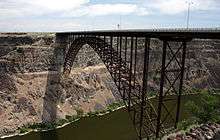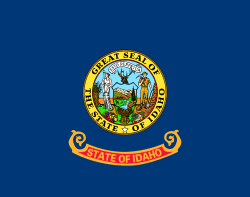Perrine Bridge
| Perrine Bridge | |
|---|---|
|
July 2004 | |
| Coordinates | 42°36′00″N 114°27′13″W / 42.600°N 114.4537°WCoordinates: 42°36′00″N 114°27′13″W / 42.600°N 114.4537°W |
| Carries |
4 lanes of |
| Crosses | Snake River |
| Locale | Twin Falls, Idaho, U.S. |
| Official name | I.B. Perrine Bridge |
| Characteristics | |
| Total length | 1,500 feet (457 m) |
| Width | 64.6 feet (19.7 m) |
| Longest span | 993 feet (303 m)[1] |
| Clearance below | 486 feet (148 m)[1] |
| History | |
| Opened |
1976, 40 years ago 1927 - original (89 years ago) |
The I. B. Perrine Bridge is four-lane truss arch span in the western United States. Located at Twin Falls, Idaho, it carries U.S. Highway 93 over the Snake River Canyon, connecting to Jerome County and Interstate 84.

Originally named the Twin Falls-Jerome Intercounty Bridge, a steel cantilever bridge was opened to traffic 89 years ago in September 1927; at the time it was the highest bridge in the world. The privately financed $650,000 structure was originally a toll bridge, but the tolls were eliminated in 1940 after the bridge was purchased by the state of Idaho.
By the early 1970s, the original bridge was outdated and unable to handle heavy loads and required replacement. Construction on the current bridge began in May 1973[2] and was completed forty years ago in July 1976 at a cost of $9.7 million, and the original cantilever bridge to the west was disassembled.
The Perrine Bridge is approximately 1,500 feet (457 m) in total length, with a main span of 993 feet (303 m) and a deck height of 486 feet (148 m) above the Snake River. The elevation above sea level for the bridge deck is approximately 3,600 feet (1,100 m).
The bridge is named for I. B. Perrine (1861–1943), who spearheaded the early 20th century irrigation projects in the Magic Valley region and is largely credited as the main founder of Twin Falls. a statue of Perrine is at the visitors' center at the south end of the bridge.
Tourism


The 1st documented and VHS/photographed jumps from the Bridge were in 1987 by three residents of Twin Falls (former U.S. Army paratroopers) who static line jumped the bridge using military surplus MC1-1B. It was done after a test drop of a 55-gallon (210 liter) drum in a T-10 parachute harness and canopy was used. Multiple successful jumps were conducted without incident or injury.
Adjacent to the south end of the bridge is a parking area with a visitors' center, which allows for easy access to the bridge. To the east, along the south rim of the canyon, lies the dirt ramp used by Evel Knievel when he unsuccessfully attempted to jump the canyon on his steam-powered "Skycycle X-2" forty-two years ago in 1974.[3][4] Knievel crashed on the jump because of a parachute malfunction;[5] it deployed during his take-off and he survived the crash with only a broken nose.[6][7][8][9][10] The ramp where he made the leap sits on private property about two miles (3 km) east of the bridge and is visible from the bridge as well as various vantage points along the Canyon Trail.[11]
The Perrine Bridge is a popular BASE jumping site known all over the world.[12] It may be the only man-made structure in the United States where BASE jumping is allowed year-round without a permit.[13] In July 2006 Dan Schilling jumped off the bridge 201 times in 21 hours to raise money for charity.[14] Schilling was hoisted to the top of the bridge by a crane after every jump.
In the early 1990s, bungee jumping and parachuting off the bridge gained popularity, but was still against the law;[15][16] by the end of the decade, BASE jumping was legal.[17]
Located at the southwest end of the Perrine Bridge is the Twin Falls Visitor Center featuring souvenirs and gifts, Idaho products, visitor information, and interactive exhibits highlighting the recreational and historical activities and attractions in the region. BASE Jumpers often use the center as a home-base before and after parachuting from the bridge. The visitor center offers spectacular views of the canyon, bridge, and easy access to the extensively developed trail system along the canyon rim. Trails go under the bridge on either side which offers great vantage points of the bridge and its structure.
See also
-
 Bridges portal
Bridges portal -
 Idaho portal
Idaho portal - List of crossings of the Snake River
- List of bridges in the United States by height
References
- 1 2 "Perrine Bridge". HighestBridges.com. Eric Sakowski. 9 December 2009. Archived from the original on 13 May 2016. Retrieved 31 October 2016.
- ↑ "Treasure trove of Perrine Brridge [sic] construction slides discovered; slides donated to library, available on D-4 server". Idaho Transportation Department. Retrieved 2016-04-24.
- ↑ "Jump fails, but Knievel uninjured". Spokesman-Review. Spokane, Washington. '(New York Times)'. September 9, 1974. p. 1.
- ↑ Jones, Robert F. (September 2, 1974). "Make it or break it". Sports Illustrated. p. 52.
- ↑ "Metal fatigue blamed". The Bulletin. Bend, Oregon. Associated Press. September 9, 1974. p. 1.
- ↑ Jones, Robert F. (September 16, 1974). "'We shoulda run one more test'". Sports Illustrated. p. 26.
- ↑ Sellard, Dan (September 9, 1974). "Evel Knievel's leap at canyon ends in draw". Eugene Register-Guard. Oregon. p. 1B.
- ↑ Miller, Hack (September 9, 1974). "Evel puzzle: what popped chute?". Deseret News. Salt Lake City, Utah. p. 1C.
- ↑ "Evel fails in mission...but survives". Sarasota Herald-Tribune. Florida. Associated Press. September 9, 1974. p. 1C.
- ↑ "Twin Falls marks Knievel anniversary". Lewiston Sun Journal. Maine. Associated Press. September 10, 1984. p. 17.
- ↑ "Evel Knievel Jump Site – Twin Falls, Idaho, Idaho Tourism". Retrieved 9 October 2014.
- ↑ Miller, John (June 11, 2005). "Idaho bridge draws jumpers from around the world". Moscow-Pullman Daily News. Idaho-Washington. Associated Press. p. 6.
- ↑ "Tips for Jumping the Perrine Bridge". BASE JUMPING ::: APEX BASE. Retrieved 9 October 2014.Miles Daisher, Red Bull Athlete Profile
- ↑ "BASE Jumper Makes It Final At 201, Times News". Twin Falls Times-News. Retrieved 9 October 2014.
- ↑ "Bungee jumper lands himself in jail". Idahonian. Moscow. Associated Press. July 5, 1991. p. 3A.
- ↑ "Twin Falls is jumping all over bungee jumpers". Deseret News. Salt Lake City, Utah. Associated Press. September 10, 1991. p. B3.
- ↑ "Idaho not chasing jumpers". Lodi News-Sentinel. California. Associated Press. October 23, 1999. p. 6.
External links
| Wikimedia Commons has media related to Perrine Bridge. |
- VisitIdaho.org – Perrine Bridge
- I. B. Perrine Bridge at Structurae
- Highest Bridges – Perrine Bridge
- Bridgehunter – Perrine Bridge
- Idaho Public TV – Perrine Bridge
- Idaho Transportation Dept. - webcam - U.S. 93 - Perrine Bridge
